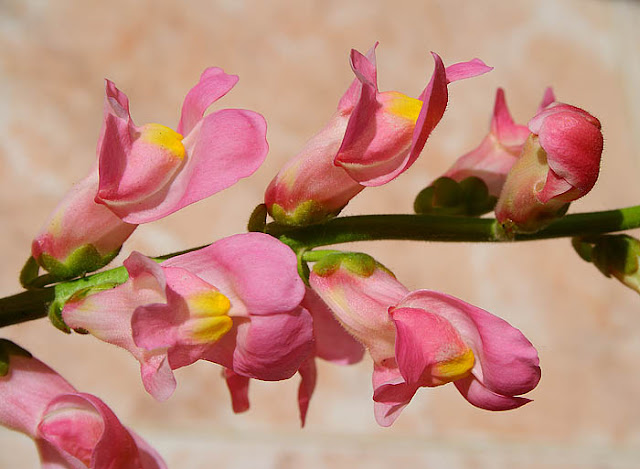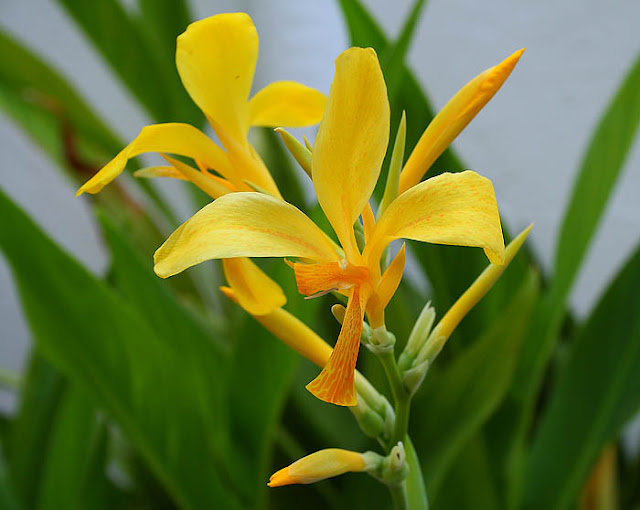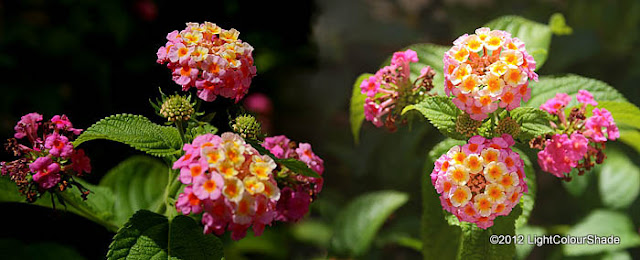I stumbled upon this beautiful bush growing wild in the field in an unexpected place. It turns out it's Garland chrysanthemum, botanically Chrysanthemum coronarium or Leucanthemum coronarium, also known as chrysanthemum greens or edible chrysanthemum, native to the Mediterranean and East Asia. It is a leaf vegetable in the genus Chrysanthemum.
.jpg) |
| Garland chrysanthemum (Chrysanthemum coronarium, Leucanthemum coronarium). (© 2012 LightColourShade. All rights reserved) |
.jpg) |
| Garland chrysanthemums (Chrysanthemum coronarium, Leucanthemum coronarium). (© 2012 LightColourShade. All rights reserved) |
Thunbergia alata (Black-eyed Susan vine) and other annuals, perennials, and shrubs of this genus are native to warm or tropical regions of Africa, Madagascar, and Asia. Its showy, five-lobed flowers have slender tubes that open to form undulating trumpets.
 |
| Black Eyed Susan Vine (Thunbergia alata) (© 2012 LightColourShade. All rights reserved) |
+flowers.jpg) |
| Black Eyed Susan Vine (Thunbergia alata) flowers (© 2012 LightColourShade. All rights reserved) |
Pelargonium is a genus of flowering plants which includes about 200 species of perennials, succulents, and shrubs, commonly known as scented geraniums or storksbills. This one is Pelargonium domesticum or regal geranium.
 |
| Pelargonium domesticum or regal geranium (© 2012 LightColourShade. All rights reserved) |
Pelargonium graveolens is a species in the Pelargonium genus, which is indigenous to various parts of southern Africa, and in particular South Africa. Common names include rose geranium, old fashion rose geranium and rose-scent geranium. It is often called geranium as it falls within the plant family Geraniaceae, although more correctly, it is referred to as Pelargonium. This specific species has great importance in the perfume industry. It is cultivated on a large scale and its foliage is distilled for its scent. Every time you rub the leaves or just touch them they give off sweet fragrance.
P. graveolens cultivars have a wide variety of smells, including rose, citrus, mint, coconut and nutmeg, as well as various fruits. However, the most commercially important varieties are those that have rose scents. Still, I haven't figured out yet what fruit or flower my pelargonium graveolens geranium smells like.
This year turned out to be a very good year for my plant — it blossomed profusely.
+flowers+close-up.jpg) |
| Pale lilac geranium (Pelargonium graveolens) flowers close-up (© 2012 LightColourShade. All rights reserved) |
Once again osteospermum or South African daisy, this time it's the purple variety. I found it in the field and planted a shoot in a flower pot. It flourished and produced beautiful flowers.
+flower.jpg) |
| Purple Osteospermum (African Daisy, South African Daisy, Blue-eyed Daisy) flower (© 2012 LightColourShade. All rights reserved) |
+flower+close-up.jpg) |
| Purple Osteospermum (African Daisy, South African Daisy, Blue-eyed Daisy) flower close-up (© 2012 LightColourShade. All rights reserved) |
And this is the parent plant in the field.
+in+the+wild.jpg) |
| Purple Osteospermum (African Daisy, South African Daisy, Blue-eyed Daisy) flower in the wild. (© 2012 LightColourShade. All rights reserved) |
Gladiolus (from Latin, the diminutive of gladius, a sword), aka the sword lily is a genus of perennial bulbous flowering plants in the iris family (Iridaceae).
The genus is distributed in Mediterranean Europe, Asia, Tropical Africa and South Africa. The centre of diversity of the genus is located in the Cape Floristic Region.
 |
| Gladiolus flowers. (© 2012 LightColourShade. All rights reserved) |
Caesalpinia gillesii, Yellow Bird of Paradise, or Desert Bird of Paradise is a shrub in the legume family with showy yellow flowers with long red stamens through most of the warm season. It's very xeric and hardy, needs little water, full sun, well drained soil. It's deciduous, but may be evergreen in warmer areas.
It is a striking ornamental plant native to tropical America, mainly Argentina and Uruguay.
Medicine men of peoples indigenous to the Amazon Rainforest used this plant and the similar Caesalpinia pulcherrima, which they called ayoowiri, for curing fever, sores, and cough. Four grams from the root is also said to induce abortion in the first trimester of pregnancy. However, it must be noted that the seeds and the green seed pods of this plant are toxic, provoking severe vomiting and other abdominal symptoms.
 |
| Caesalpinia gillesii (Yellow Bird of Paradise) flower (© 2012 LightColourShade. All rights reserved) |
Antirrhinum is a genus of plants commonly known as snapdragons or dragon flower from the flowers' fancied resemblance to the face of a dragon that opens and closes its mouth when laterally squeezed (thus the 'snap').
.jpg) |
| Pale pink Antirrhinum (snapdragon, dragon flower) (© 2012 LightColourShade. All rights reserved) |
Mandevilla splendens, also called Dipladenia splendens, is an evergreen vine belonging to the Mandevilla genus and native to Brazil. Mandevilla splendens climbs by twining and can grow to 3 meters (10 feet) high. There is something very graceful, tender and delicate about this flower.
 |
| Mandevilla splendens. (© 2012 LightColourShade. All rights reserved) |
Erythronium grandiflorum is a species of flowering plant in the lily family which is known by several common names, including yellow avalanche lily, glacier lily, and dogtooth fawn lily.
It is native to western North America from California to Alberta to New Mexico. It can be found in subalpine mountain meadows, slopes, and clearings.
The flower is pollinated by bumblebees and other bees. The bulbs are an important and preferred food of the grizzly bear, while mule deer prefers the foliage.
 |
| Yellow lily flower. (© 2012 LightColourShade. All rights reserved) |
Lantana camara, also known as Spanish Flag or West Indian Lantana, is a species of flowering plant in the verbena family, Verbenaceae, that is native to the American tropics. It comes in pink and pale yellow or
 |
| Pink Lantana camara flowers. (© 2012 LightColourShade. All rights reserved) |
.jpg) |
| Lantana camara (Spanish Flag). (© 2012 LightColourShade. All rights reserved) |
Yucca is a genus of perennial shrubs and trees in the family Asparagaceae, subfamily Agavoideae. Its 40-50 species are notable for their rosettes of evergreen, tough, sword-shaped leaves and large terminal panicles of white or whitish flowers. They are native to the hot and dry (arid) parts of North America, Central America, South America, and the Caribbean. It is also colloquially known in the midwest United States as "Ghosts in the graveyard", as it is commonly found growing in rural graveyards and when in bloom the flowers appear as an apparition floating. Well, like this one in the local grove — I have to admit when I bumped into it in the late evening, it did look like a sort of spectral ghost.
 |
| Yucca flower (© 2012 LightColourShade. All rights reserved) |
A really lovely post. But I just have to say that your chrysanthemum in the first photo just grabbed my attention. So simple - so elegant. But my favorite, for reasons of my own peculiar childhood, was your first of the lantana photos. I can almost smell their strange aroma. Thanks.
ReplyDeleteThank you. You're right, I, too, have favourite flowers for sentimental reasons of my childhood, like mirabilis jalapa or oleanders. Sometimes it's not just the beauty of the flower, but what it reminds us of.
Delete